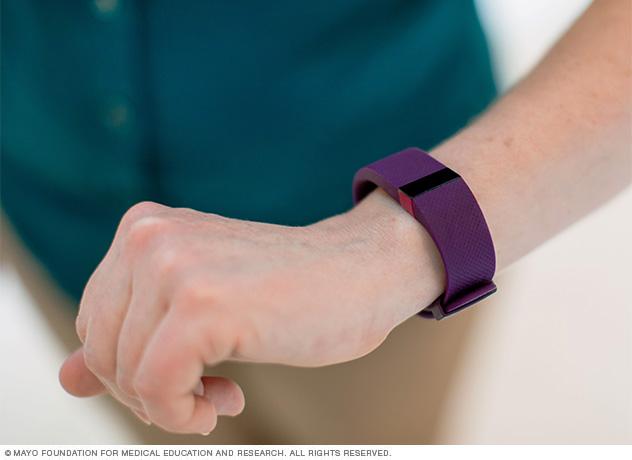My LDC Benefits
Walking: Make it count with activity trackers
If walking is your main form of physical activity, see how activity trackers can help you set and achieve your fitness goals.
Walking is a great way to get and stay fit. But are you doing enough to see results? Using activity-tracking devices and apps can help you set and reach your fitness goals. See how these tools can get you started toward your goals.
What are activity trackers?


Activity tracker
An activity tracker can be used to count steps, find out distance traveled and monitor other fitness information.
Activity trackers, also known as activity monitors or fitness trackers, are the modern equivalent of pedometers. But they do more than count steps.
Activity trackers can determine how far you've traveled and what type of movement you were doing, such as walking, jogging or swimming. And many activity trackers measure sleep quality and length, compute calorie intake and the number of calories burned, monitor your heart rate, check skin temperature and sweating levels, and serve as alarm clocks or watches. Some can even monitor your blood-oxygen levels. And many activity trackers can track your location.
Some display your progress in real time. All can show it later on a smartphone, tablet or computer. Some activity trackers can sync with smart devices, such as a smart bathroom scale. They can even provide social support through apps or websites. And activity trackers can assist with your goal setting by giving cues and rewards to encourage healthy behaviors.
Many activity trackers are made to be worn on your wrist, like a watch or bracelet, although some can be clipped to your clothing. Most can be worn for 24 hours. Many trackers have alerts for calls, texts or emails. Although they are not totally accurate, they are generally accurate and can provide some helpful activity information.
Choosing the right device
How do you know what kind of activity tracker to get? Review these features to see which device may best suit your needs and interests.
- Ease of use. Although some activity trackers have more features and require more setup than do others, most are quite simple to use. After you've set up the device, just strap it on your wrist and go.
Extras. The amount of information you want to collect may influence your choice of device. Most activity trackers calculate time spent in an activity, distance traveled and even the number of calories you burn while being active. Some activity trackers may also monitor your heart rate. Many activity trackers allow you to upload your data to computers or apps so that you can electronically track your progress.
You might prefer a certain style of device, and a variety of styles are available. Some devices have a shorter battery life than others. Also, if you like to swim and want to wear an activity tracker in the water, make sure that you get a waterproof device.
- Accuracy. Most activity trackers are generally accurate and reliable at counting basic steps.
- Display. Look for a device with a display that you can read in different types of lighting, especially if you'll be using it both indoors and outdoors.
- Price. The cost of an activity tracker can depend on how many features it offers. Activity trackers are available in a wide range of prices.
Setting and reaching your fitness goals
About 70% of U.S. adults don't get the recommended amount of overall physical activity. For most healthy adults, the Department of Health and Human Services recommends at least 150 minutes of moderate aerobic activity or 75 minutes of vigorous aerobic activity a week, or a combination of moderate and vigorous activity.
In general, aim for about 30 minutes of aerobic activity most days of the week. This should be at a moderate level, such as a fast-paced walk. For even more benefits, aim for about 60 minutes of aerobic activity most days of the week. Aim to incorporate strength training exercises at least twice a week.
If you're not at that level of activity yet, keep it in mind as you think about your long-term goals. And keep in mind that any activity is better than none at all.
Activity trackers provide immediate feedback about your activity level. So, they can serve as a strong motivator to keep you moving. And they can help you track your progress over time.
Use these tips to integrate an activity tracker into your daily routine:
- Establish a baseline. When you first get your tracker, wear it throughout the day for about a week. Go about your routine activities at home or work. At the end of the week, add up the total number of steps for each day and divide that total by 7. This gives you an average number of steps to use as a baseline for setting your step goals.
- Set short-term step goals. Once you know how many steps you generally take on an average day, you can set some short-term activity goals. If you take 2,000 steps a day set a short-term goal of adding 1,000 steps a day for two weeks. You can add the steps all at once. Or break your walking into short chunks of time. When you meet a short-term goal, add a new one.
- Set long-term step goals. Think about your overall fitness and activity goals. Your short-term goals are the building blocks to these long-term goals. A long-term goal may be walking 10,000 steps a day, or about 5 miles (8 kilometers), several times a week as part of your new daily routine. Some studies suggest that walking 7,000 steps a day may be enough to prolong your life. Or your goal might be to walk briskly for 30 minutes, five days a week. You may also want to set a goal of walking faster as your fitness level improves.
Track your progress. To see how you're doing, monitor your progress over time. Some trackers have a memory function to track steps on a weekly or monthly basis.
If your tracker has that function, you can choose to use that feature. You can record your steps in a log of your own making, too. Or upload the information digitally to your computer or mobile device. Tracking your progress can help you see whether you're meeting your goals and when it may be time to set fresh goals.
Keep your health care provider in the loop
If you have any health issues, have been inactive or are very overweight, be sure to talk to your health care provider before starting a new fitness program. Your provider can help you set realistic goals based on your fitness level and any health issues you may have.
Whatever your fitness goals, take them one step at a time. And enjoy the feeling of knowing that you're on the path to better health and fitness.
© 1998-2023 Mayo Foundation for Medical Education and Research (MFMER). All rights reserved.


